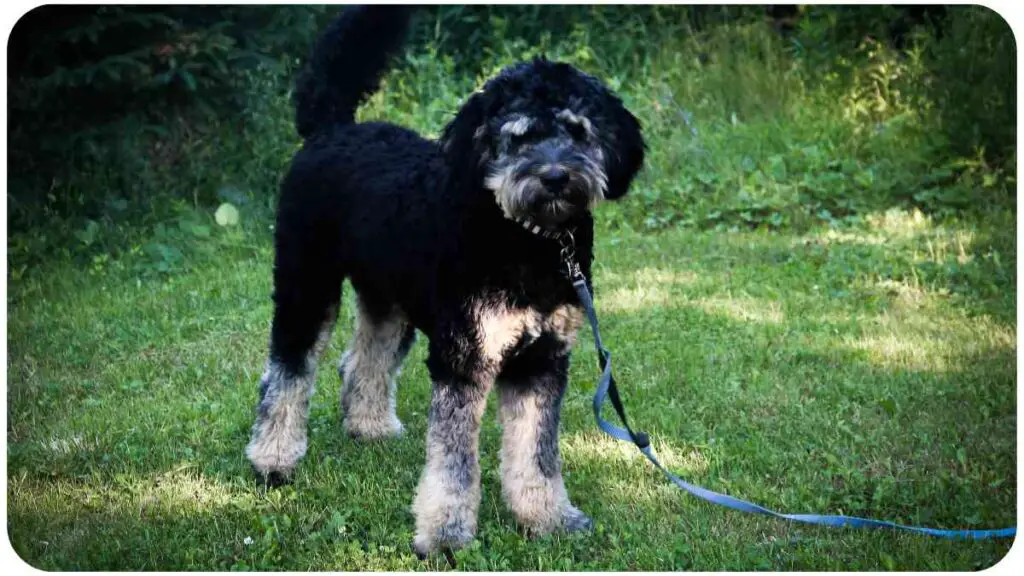Welcoming a Bernedoodle puppy into your home is an exciting and rewarding experience. This guide will provide you with comprehensive insights into caring for your Bernedoodle, from understanding their breed to practical tips on grooming, training, and health considerations.
| Takeaway |
|---|
| Bernedoodles, a hybrid of Bernese Mountain Dogs and Poodles, offer a mix of personalities and coat types. |
| Understanding their characteristics, care needs, and training requirements is crucial for responsible ownership. |
| Bernedoodles come in three sizes—Standard, Miniature, and Tiny—each with its own exercise and living space preferences. |
| Grooming varies based on coat type, and regular veterinary check-ups are essential for their overall health. |
| Responsible breeding practices contribute to healthier Bernedoodles, minimizing potential inherited health issues. |
| Positive training methods, early socialization, and consistent care lead to well-behaved and friendly Bernedoodle companions. |
2. Understanding Bernedoodle Breed

2.1 Brief Background
The Bernedoodle, a crossbreed between a Bernese Mountain Dog and a Poodle, has gained popularity over the last two decades. Despite being a newer breed, their unique characteristics make them an ideal companion.
Thinking of bringing home a Cavapoo? Navigate the ins and outs of Cavapoo care with our comprehensive guide. From nutrition to grooming, we’ve got you covered.
2.2 Characteristics
Bernedoodles come in various sizes, coat colors, and types. Ranging from tiny to standard, their coats can be curly or straight, with different shedding tendencies. It’s crucial to understand these variations to provide the best care.
| Size | Weight Range | Coat Types | Common Colors |
| Tiny | 10-24 pounds | Straight or Curly | Black, Tri-color |
| Miniature | 25-49 pounds | Wavy to Curly | Black and White |
| Medium | 50-74 pounds | Variable | Black and Brown |
| Standard | 75-90 pounds | Curly to Wavy | Tri-color |
2.3 Ideal Living Environment
No matter the size, Bernedoodles need adequate exercise. Tiny and Mini Bernedoodles adapt well to urban living, while Medium to Standard sizes require more space for exercise.
3. Bringing Home a Bernedoodle Puppy
3.1 Size Considerations
When choosing a Bernedoodle, consider your living space. Tiny and Mini Bernedoodles suit urban environments, while Medium to Standard sizes thrive in more spacious settings.
Ensure your feline friend breathes clean air. Discover the best air purifier for cats with our detailed guide. Create a healthy environment tailored for your cat’s well-being.
3.2 Coat Varieties
Understanding your Bernedoodle’s coat is essential for proper care. Curly coats shed less and are hypoallergenic, making them suitable for allergy sufferers. Straighter coats may require more frequent brushing.
| Coat Type | Shedding Tendency | Allergenic | Recommended Grooming Frequency |
| Curly | Low | Yes | Every few months |
| Straight | Moderate | No | Every other day |
4. Bernedoodle Puppy Personalities

4.1 Goofy Traits
Known for their goofy, smart, and loyal nature, Bernedoodles inherit positive traits from both parent breeds. Training and socialization are key to fostering friendly behavior.
Curious about Affenpinscher litters? Uncover answers on Affenpinscher litter size. Explore factors influencing the size of Affenpinscher litters and ensure optimal care.
4.2 Intelligence and Trainability
Bernedoodles are intelligent and trainable, but their stubborn streak may emerge during adolescence. Establishing a daily routine and incorporating basic obedience training with positive reinforcement is crucial.
4.3 Exercise Needs
While Bernedoodles are considered working dogs, moderate exercise is sufficient. One to two longer walks, coupled with play sessions, keeps them content. Adjust the intensity based on your puppy’s size.
5. Bernedoodle’s Ideal Living Environment
5.1 Urban Living
Tiny and Mini Bernedoodles adapt well to urban living, thriving in tighter spaces like apartments or condos. Their activity needs are slightly lower, making them suitable for a more relaxed urban lifestyle.
Embarking on a pet adoption journey in Pennsylvania? Our guide on how to adopt a pet in Pennsylvania walks you through the process, ensuring a smooth transition for your new companion.
5.2 Spacious Dwellings
Medium to Standard-sized Bernedoodles, being larger, need more space to exercise and play. A fenced yard or access to a nearby park is ideal for this breed, allowing them to expend energy and stay healthy.
6. Caring for Your Bernedoodle Puppy
6.1 Veterinary Care
Schedule a first veterinarian visit within the first week of bringing your Bernedoodle puppy home. Discuss nutritional needs, growth development, vaccinations, and spaying/neutering schedules.
6.2 General Care Tips
- Brush their teeth regularly to avoid dental issues.
- Check and clean their ears to prevent infections, especially in floppy-eared Bernedoodles.
- Grooming frequency depends on coat type; curly coats may require more attention.
- Professional grooming every few months helps maintain their fur.
Encountering issues with your Furbo Dog Camera? Dive into our troubleshooting guide for tips and connectivity solutions. Keep your pup in sight and resolve connectivity challenges effortlessly.
7. Puppy Trainer’s Advice for Raising a Well-Behaved Bernedoodle
7.1 Daily Training Schedule
Create a structured daily routine for your Bernedoodle puppy, including feeding, sleep, playtime, and training sessions. Establishing early structure helps mitigate stubbornness and establishes your leadership.
7.2 Socialization
Given their friendly disposition, early socialization is crucial. Introduce your puppy to various people, children, and other pets. Controlled interactions on a leash promote good behavior and prevent overexcitement.
7.3 Playful Training
Leverage their playful nature for training. Games like Fetch can teach commands like “Come” and “Drop it.” Use playtime sessions to instill polite manners, encouraging waiting for your cues.
7.4 Varied Training
Bernedoodles, while intelligent, may need varied motivation. Incorporate food rewards and keep training routines diverse to engage them. Enrolling in training classes or using online programs helps maintain a structured approach.
8. Additional Care Tips for Your Bernedoodle Puppy

8.1 Regular Veterinary Visits
Schedule your Bernedoodle’s first vet visit within the first week of bringing them home. Discuss nutritional needs, growth development, vaccinations, and spaying/neutering. Regular check-ups ensure a healthy and happy Bernedoodle.
8.2 Dental Care
Maintain good oral hygiene by brushing your puppy’s teeth regularly to prevent tooth decay, gum disease, and bad breath. Dental health is crucial for their overall well-being.
8.3 Ear Care
Check and clean your Bernedoodle’s floppy ears regularly to avoid infections. Floppy ears can be more prone to issues, so consistent cleaning is essential for a healthy pup.
8.4 Coat Maintenance
Depending on your Bernedoodle’s coat type, brush them accordingly. Curly coats may need frequent brushing to prevent matting, while straighter coats may shed more. Professional grooming every few months is recommended.
8.5 Exercise Routine
Adjust your puppy’s exercise routine based on their size. Smaller Bernedoodles may adapt to urban living, while larger ones need more space. Daily walks, play sessions, and access to a yard or park are ideal for their well-being.
9. Puppy Trainer’s Advice for Raising a Well-Behaved Bernedoodle
9.1 Create a Daily Puppy Training Schedule
Establish a structured routine for your Bernedoodle puppy, including feeding, sleeping, playtime, and training sessions. Basic obedience with positive reinforcement builds good behavior and helps curb any stubborn streak.
9.2 Socialization with People, Children, and Other Pets
Bernedoodles are friendly but can be reserved with strangers. Early socialization is crucial. Introduce them to various people, children, and pets, ensuring controlled interactions to prevent overexcitement or jumping.
9.3 Use Play to Help Train Them
Leverage your Bernedoodle’s playful nature for training. Incorporate games like Fetch to teach commands like “come,” “drop-it,” and “sit.” Playtime can be a valuable training tool for teaching manners.
9.4 Change Up Your Bernedoodle’s Training
Bernedoodles, being intelligent, may need varied training routines. Use food rewards and consider enrolling them in classes or using online training programs to keep them engaged, preventing boredom and enhancing their skills.
9.5 Consistency in Training
Consistency is key in Bernedoodle training. Reinforce positive behavior consistently, and avoid rewarding undesired actions. A well-structured training approach ensures your Bernedoodle grows into a well-behaved adult dog.
10. Conclusion
In conclusion, Bernedoodle puppies make wonderful companions with their friendly demeanor and varied sizes. Understanding their unique characteristics, ideal living environments, and specific care needs is essential for responsible ownership. Whether you’re a new Bernedoodle parent or considering bringing one home, following these guidelines will contribute to a happy and well-adjusted furry family member.
Further Reading
- PetMD – Bernedoodle Breed Information: Explore comprehensive details about Bernedoodle breeds, their characteristics, and essential care tips.
- The Puppy Academy – A Guide to Puppy Breeds: Bernedoodles: Gain insights from a puppy trainer’s perspective on Bernedoodles, covering their background, characteristics, and ideal living environments.
- The Spruce Pets – Bernedoodle: Full Profile, History, and Care: Delve into a detailed overview of Bernedoodle history, characteristics, and care requirements for a comprehensive understanding.
FAQs
Are Bernedoodles Hypoallergenic?
Yes, Bernedoodles can be hypoallergenic, but individual variations exist. The higher the poodle percentage, the more likely the coat is low-shedding.
What Size Range Do Bernedoodles Fall Into?
Bernedoodles come in three size categories: Standard (50 to 90 pounds), Miniature (25 to 49 pounds), and Tiny (10 to 24 pounds).
How Do I Socialize My Bernedoodle Puppy?
Introduce your Bernedoodle to various people, children, and other pets in a controlled manner. Early and consistent socialization is crucial for their friendly demeanor.
What Health Issues Are Common in Bernedoodles?
Bernedoodles can inherit health issues from Bernese Mountain Dogs and Poodles, such as hip dysplasia, eye diseases, and cardiac conditions. Responsible breeding and regular vet check-ups are vital.
How Should I Groom My Bernedoodle?
Grooming requirements vary based on coat type. Wavy and curly coats need regular brushing, and professional grooming every four to eight weeks is recommended. Straighter coats may require more frequent brushing to manage shedding.

I’m Dr. Hellen James, a professional veterinarian with a deep interest in the ways that litter size affects the health of animals. I’ve spent years studying this subject and performing research on reproduction in many different kinds of creatures.


